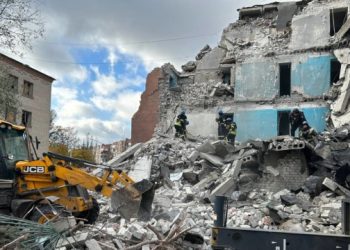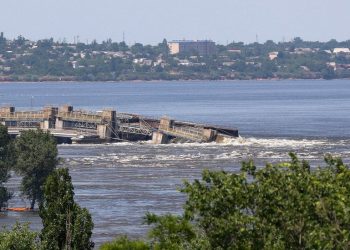Human Lives Human Rights: The Iranian military shot down Ukrainian Airlines Flight PS752 while the plane was leaving Iranian airspace on Jan. 8, 2020.
On the morning of 3 January 2020, when a CENTCOM’s UAV targeted top Iranian General Qassem Soleimani behind the International Airport in Baghdad, least did anyone expect a catastrophe to occur a few days later in order to take revenge of Soleimani’s blood, a catastrophe that killed 176 passengers and crew on flight.
On January 8, 2020, Ukrainian International Airlines Boeing 737 crashed shortly after takeoff from Tehran International Airport, Iran, killing 176 people on board. An operator of the Iranian Revolutionary Guards (IRGC), stationed in Bid Kaneh, was found to have fired two missiles from a Tor-M1 surface-to-air system, which brought down the aircraft.
This was not the only case in which the Revolutionary Guards’ defense systems fired on its planes. In 2012, the New York Times obtained confidential documents from the US Department of Defense showing that the IRGC’s defense system had mistakenly fired missiles at Iranian passenger planes, fighter jets and even UAVs in 2007 and 2008 or at least they were locked by a radar.
Also, in the early morning hours of January 26, 2012, an F14 fighter of the Iranian Air Force was targeted by the same defense system near the port city of Bushehr in south of Iran and its two pilots Alireza Karimaei and Mostafa Fasihi were killed.
The PS752 crash also called into question the safety of transit flights over Iran, an issue that led to the cessation of a large number of transit flights over Iran, and as a result, the European Authority for aviation safety issued a warning about the insecurity of flying at altitudes below 25,000 feet over Iran, a warning that was valid until October 30, 2021.
The first allegation on the Government of the Islamic Republic of Iran is that it did not close Iran’s airspace at night, which was a violation of the international law and also against the explicit text of the Chicago Convention, because according to international aviation law, the Iranian government had to close its airspace that night. However, in order to prevent the revelation of missile operations against the most important US base in Iraq, it refused to declare a no-fly zone and provided the main ground for the catastrophe.
However, this non-declaration of a no-fly zone by the Iranian government is not unprecedented, during the previous missile operations of the IRGC Air Force in 2017 and 2018, no flight zone was not announced and no warnings were even given to flights passing through Iran.
On the morning of the tragedy, officials from Australia, Canada, Britain and the United States announced that the plane had been destroyed by a defense missile, but a spokesman for the government of the Islamic Republic of Iran went behind the podium and denied the claim.
According to the official website of the Iranian government, in addition to rejecting the American claims of targeting American plane, Ali Rabiei told reporters: “Such a claim is in the direction of the American psychological war against Iran’s victory in targeting the Ain al-Assad base.”
Hours later, then-Iranian President Hassan Rouhani announced in a telephone conversation with then-Ukrainian President Vladimir Zelenskky that he was ready to form a joint expert team of experts from the two countries to investigate the crash.
The same day, the Daily Mail news website published images of the crashed plane’s fuselage with a number of holes in it, referring to the incident that took place after the missile attack on the Ain al-Assad base, it speculated that the plane may have hit an object like a military drone or a war rocket.
The Ukrainian embassy in Tehran announced in the early hours of the incident that the crash was probably due to a technical defect, but minutes later deleted the news from its website, and the next day Ukrainian National Security Council Secretary Oleksiy Danilov announced four possibilities as to why the plane crashed, these hypotheses include rocket attacks and terrorism. In the following hours, CBS and CNN reported that the hypothesis that the plane was targeted was serious, but the next day, then-President Donald Trump stated that the cause of the crash was still unknown, and he did not believe that a mechanical malfunction had caused the crash. “It was flying at a pretty rough neighborhood, and somebody could’ve made a mistake,” he said.
On January 9, the Bellingcat website announced that the plane was targeted, and the New York Times published a few short clips of the crash. On the same day, Canadian Prime Minister Justin Trudeau, British Prime Minister Boris Johnson and Australian Prime Minister Scott Morrison announced that the plane had been targeted by surface-to-air missiles, but Iranian state and military officials continued to deny the allegations.
On February 4, a Ukrainian media outlet published an audio recording of a pilot talking to one of the flights at the same time as the Ukrainian plane. According to Zelensky, the release of the audio recording of the conversations of the second pilot of Aseman Airlines shows the Islamic Republic knew immediately it had shot down a Ukrainian airliner.
Bahram Parsaei – spokesman for parliament’s Article 90 commission said: This audio file clearly shows that the aviation organization knew the reasons for the accident and there is no doubt about it! The Secretary of the Defense and National Security Council of Ukraine, overseeing the government’s investigation into the downing of the Ukrainian passenger plane, stated on April 26 that he believes that the Islamic Republic deliberately shot down the plane to possibly avoid a cycle of military tensions with the United States. These statements have been confirmed by the Ministry of Foreign Affairs of this country.
Analysts and some aerospace experts on Iran’s local media called the possibility of firing a missile at the plane a rumor, a lie, American fraud, psychological warfare and a fake scenario, created by the opponents and the West, in order to antagonize and marginalize the attack on the Ain al-Assad barracks or Boeing’s attempt to prevent the stocks from falling and to cover up the technical problems of their aircraft. They denied the downing of the plane with this shot scientifically and experimentally. Also on December 20th, Tasnim news agency, affiliated with the IRGC, based on its informed sources at Imam Khomeini airport and according to the existing flight permit form, announced that on the night of the accident, the plane had technical problems and the Iranian engineer who predicted the accident did not allow the flight to take off, but the Ukrainian airline engineer disagreed, and therefore only the engine of the plane caught fire, and there is no other reason for the plane’s crash.
This war of words and secrecy of the Iranian authorities continued for three days until finally, on 21 January 2018, the General Staff of the Iranian Armed Forces confirmed the downing of flight PS752 by the IRGC and called it a human error. In a written statement, the top military authority said as a result of a “human error”, the plane was accidentally shot down by the air defense system while it was passing over a “sensitive military point”.
Iran was on the alert to possible U.S. threats to attack many points in Iran after launching a dozen ballistic missiles targeting the U.S. troops in Iraq, it noted. Under these sensitive and crisis conditions, the plane approached a delicate military center of the Islamic Revolutionary Guards Corps (IRGC), and its height and stance seemed to be hostile, it said. The plane in question was unintentionally targeted under these conditions, it added.
According to the announcement of the Iranian Civil Aviation Organization, against the claim of turning and deviating the plane, no flight deviation has been proven by the crashed plane. This announcement was removed from this organization’s website shortly after it was published. The Flight Radar24 website also announced by publishing its satellite images and maps that the path of the Ukrainian plane was completely normal without turning or going off course or moving to another place and it was on the usual route of airport flights.
After the publication of this news, the IRGC commanders announced that they mistook the Ukrainian passenger plane for a cruise missile and that it was not the reason for the plane’s rotation or deviation. The commander of IRGC Aerospace Force stated that although Iran’s defense forces were on the highest level of alert that night, but due to some security and military considerations, no fly zone was not declared.
Amir Ali Hajizadeh, commander of Aerospace Force of the Islamic Revolutionary Guard Corps said Iran’s air defense systems had been put on the “highest level of readiness” and alerted to a possible cruise missile attack prior to the plane crash incident. He added that the operator manning the system had repeatedly called for a halt in flights in the region during the night. The operator then identified what his air defense system had detected as an incoming cruise missile 19 kilometers away. The operator, as required by military guidelines then proceeded to call for orders to deal with the perceived threat, but wasn’t able to do so as his communication network failed to work. The operator then “took the wrong decision” of firing on the perceived threat in a “ten-second” time span to shoot or ignore the flying object.
Forbes magazine, in a research article by examining the different conditions of the plane and defense, shows that the air defense operator had at least 1 minute and 53 seconds and a maximum of 3 minutes and 39 seconds to make a decision before firing at the plane.
In his first official statement, the president of Iran at the time, Hassan Rouhani, emphasized that, contrary to what the commanders of the Revolutionary Guards Corps declared about individual mistakes, he said, one person cannot be solely responsible for the plane crash. The responsibility falls on more than just one person, there are others, too, and I want that this issue is expressed honestly, he said.
Ukrainian officials believe that if the Ukrainian investigation team had not found enough evidence, Iran had not taken the responsibility for the downing of this plane. According to these officials, what forced Iran to admit the role of its military in the downing of the plane was the clear evidence that it was hit by a missile that Ukrainian experts collected since arriving at the crash site on Thursday, January 9. In this case, several main and key charges are against the government of the Islamic Republic of Iran.
Firstly, the Islamic Republic of Iran was supposed to declare a no-fly zone in order to carry out missile operations according to international laws, and the excuse that the no-fly zone was not declared due to security and military considerations cannot cover the crime of shooting down a passenger plane.
Secondly, at least the Iranian airport authorities should have informed the pilot of the missile operation before the flight, so that the pilot could fly with the knowledge of possible dangers.
Thirdly, the location of the plane crash should have been announced until the arrival of the quarantine expert teams, but not only was no quarantine established to preserve the evidence, but on the order of the Iranian authorities, the evidence was quickly collected from the accident site and the bulldozers leveled the crash site so that no evidence remained.
Fourthly, the Iranian authorities, knowing that the plane was destroyed by the IRGC, hid this fact for three days and tried to cover up this crime.
Fifth, the Iranian authorities interfered with the presence of international experts at the scene of the accident and refused to hand over the plane’s black boxes to international authorities, including ICAO.
In the first part of this article, we aimed to acquaint the audience with the description of the event, the positions and finally the accusations against the government of the Islamic Republic of Iran, without the usual media orientations. In the second part, we will examine the legal dimensions and also examples of human rights violations in this horrible crime.


















